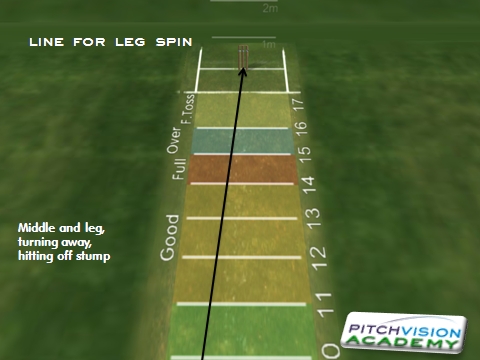In another guest article, club left arm spinner AB talks us through exactly where to land the ball to cause maximum damage to batsmen’s averages. Courtesy Pitchvision Academy
We all know the key to top quality spin bowling is to bowl a consistent line and length. But what does that actually mean?
First we need to figure out where is the best length to bowl.
We want a length that is full enough that the batsman is forced to come forward, but not so full that he is able to reach the ball on the half volley without mis-hitting it.
Consider that the average spin bowler delivers the ball at approximately 50mph, and that after bouncing the speed of the ball is reduced by about 50%. This translates to a speed of about 10 metres a second. The average reaction time of a human is 0.2s. If we pitch the ball within 2 metres of the batsman, then he will be unable to play back as he would simply not have time to react to any movement off the pitch.
Therefore the maximum distance away from the batsman's stumps that we should land the ball, given that he will move back one foot when playing back, is approximately 11 foot. Anything shorter than 11 foot and the batsman will be able to play comfortably off the back foot.
How about minimum distance?
A batsman playing on the front foot normally plays the ball about 3 feet in front of his crease. The ideal location to pitch the ball is the one at which the ball has just turned enough to hit or just miss the edge of the bat. On a normal pitch, we will find the ball turning something in the order of 5 degrees, which translates to about 1 inch sideways for each foot after bouncing.
Therefore we need to pitch the ball between 2 and 4 foot in front of the bat (8 to 10 foot from the stumps) in order to take the edge.

On a turning track, a ball pitching only a foot in front of the bat would be sufficient to threaten the edge.
The best length on this pitch would therefore be between 7 and 9 foot from the batsman's stumps. So the spin bowler has an area of about 4 feet, or just over a metre, in which to aim: anything inside this will pose the batsman problems.
------Also read
Good Length and Right Speed
-------
Spinner’s line
No matter the pitch, the ball will not always turn a consistent amount. This variability of turn is major positive factor for the spinner. If he can't predict what will happen, how can the batsman be expected to?
A competent batsman will most likely play the percentages and play for a small amount of turn when defending off the front foot, reducing the likelihood of a ball that turns just 1 or 2 inches catching the edge. However, the inadvertent result of this is that now both the big turning delivery and the straight ball are the potential wicket taking deliveries. The spinner must always take advantage of this by ensuring that every time the ball beats the bat, whether the inside edge or outside edge, then there is a decent probability that the batsman will be dismissed.
Batsmen are able to play more assertively when they feel comfortable that they are able to use their pad as a second line of defence without the risk of being dismissed lbw. This is why it’s important for a spin bowler to constantly attack the stumps with either the big spinning delivery, the straight ball, or both.
We therefore want to keep as many deliveries as possible ending up in the danger zone: either on the stumps for a chance of bowled or lbw or within 6 inches of off stump for a likely caught behind chance.
On a spinning pitch, then 10 degrees of turn will translate to a difference of about 15 inches between the straight ball and the big turning delivery. So we need to take this into consideration when planning our line of attack.

If the ball is turning away from the batsman, the ideal stock line is to pitch the ball on middle and leg, with the straight delivery angled in towards leg stump. Spin the ball hard enough for the spinning delivery to hit or go past the top of off stump.
The batsman will then be forced to play down a middle stump line to defend against the spin, and this will mean that both the straight delivery and the big spinner will have a good chance of dismissing him.
The off spinner should ensure that his big spinning delivery is not wasted by constantly turning down the leg side. This means that he needs to pitch the ball just outside off stump. A sensible batsman will then play down the line of off stump to defend against the spin, leaving both the big spinner and the straight ball as wicket-taking options.

No comments:
Post a Comment